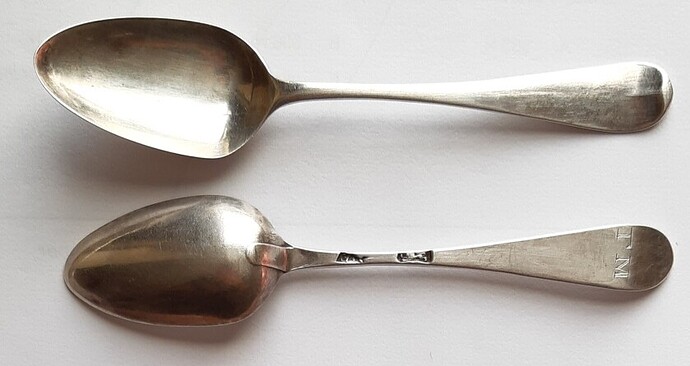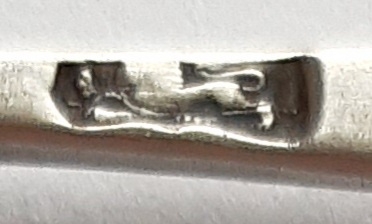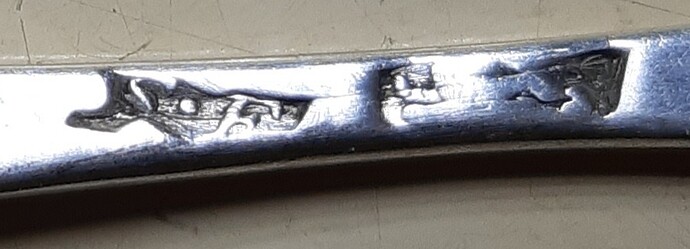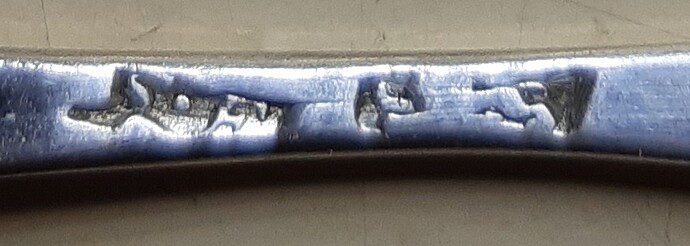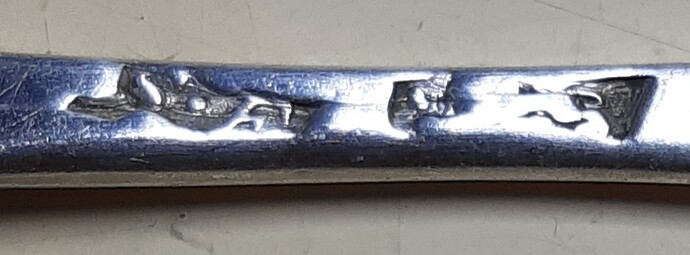Good day, friends.
I have come across a few sterling silver teaspoons with only two hallmarks on them. They seem to have been made by the same maker. The hallmarks are a maker’s mark and a lion passant. The pattern seems to be Hanoverian, with initials TM engraved on the underside of the finial. I’m attaching six pictures showing a pair of the spoons as a whole, the lion passant, and four pics concentrating on the maker’s mark. I was initially stumped by them, as they cannot be ID’ed with the help of my trusty little book. I think they date to a quite early age. I have gleaned that the lion passant was introduced in 1544 as a sterling standard mark. Might I be wrong by guessing the spoons’ age as perhaps as old as middle 18th century? I’m fascinated by the unusual marking on these spoons. Could you please help with identifying the maker? Seems to be SE with a dot in between?
Regards
Jan
Full hallmarks were not always applied at the time these spoons were made. What I can say with near-100% certainty is that these are London spoons and I am also pretty sure that the maker is Samuel Eaton who was active during the 1760s.
Phil
Phil, thank you so much for your enlightening reply! It is much appreciated.
In reading up on Samuel Eaton I found it strange not to get clarity about his family. There is a John Eaton who seems to have been a silversmith, but I was not able to find out anything about him, nor his mark. John could have been Samuel’s father. It is also probable that William Eaton (1804, 1843), mark “W.E” and “WE” might have been a son of Samuel, and Elizabeth Eaton (1847,1857), mark “EE” a granddaughter. I have nothing definite about that.
Lastly, I found it also strange that Samuel’s mark and the cartouche within which the initials are set, are so uneven as shown in my pictures. The cartouche is not even aligned with the stem. In larger silver items that I have looked up, the “S.E” is set in a nice, neat, rectangular cartouche.
Regards
Jan
The distortion is a result of the way that marks were struck at the time. Marks along the stem would have distorted the silver which then had to to be hammered back into shape. And makers’ marks were applied by the maker, or in his workshop anyway.
This forum may cast some light on the Eaton Family:
Son of George Eaton the Elder, of Scaldwell in the county of Northampton, husbandman.
He and John Eaton were uncle and nephew, - see John Eaton [http://www.925-1000.com/forum/viewtopic for details of the family and the transfer of apprentices from John to Samuel .
So John and Samuel are related. The famous Eaton family of silversmith of the next century William and Elizabeth probably produced the most reliable heaviest flatware of anybody.
They weren’t usually flash but if there a peice for sale or a set buy it. It contrasts nicely with the Bateman family production in the same period which tends to be lighter.
William got off to a very rocky start and might easily have found himself transported to Australia
A lot of Elizabeth Eaton silverware is overstamped by Channel Island makers and sold there under local marks. I featured this in a different post on a different post in this forum.
I bought a long set of plain fiddle flatware thus treated which had been bought in London by the Jersey Silversmith, used lightly for about a century hidden during the German occupation and shipped back to London as scrap after the war ended.
The North American Eaton silversmiths are also not related to the Northamptonshire farmers In the US they became federal period smiths of great renown and items by them have traded for five figures. In Canada the Eaton Family because retail royalty and trace their origins to both Ireland and Scotland.
In Northampton the Eaton family traces back to Elizabeth I in Woodford now Woodford Halse and numerous other communities in the county.
The name is fairly widely used and refers to an island or river settlement by origin. It survives in hamlets like Church Eaton in Staffordshire where my grandfather was rector in the 1930’s and early 40’s.
So your spoons are fun.
Here’s a video explaining the difference between Hanovarian and Old English
CRWW
Guildhall Antiques
Toronto,
CRWW, I am so glad that you have “entered the fray” all the way from Toronto, and you have contributed greatly with what you offered. So now I would like to contribute further. If I may, I’ll do it with a summary of my own, with facts, conclusions, assumptions and perhaps wild guesses, which are, understandably, open to rebuttal. I have indicated clearly where I am unsure of my facts. Here goes:
It is recorded that Samuel Eaton took in an apprentice in 1738, so he must have been a silversmith by that time, making buckles. By about 1745 Samuel Eaton, working from Huggin Lane, Wood Street, London, was already known as an eminent buckle-maker. (Interestingly, Huggin Lane, Wood Street no longer exists in modern London. Instead, the street connecting Gutter Lane to Wood Street is Goldsmith Street, presumably named after the Goldsmiths’ Hall located nearby.)
Samuel Eaton was the son of George Eaton the Elder, of Scaldwell in the county of Northampton, husbandman. Today we would refer to him as a farmer.
I’m assuming that Samuel Eaton did not make flatware from the start. It was only in February 1759 & 1761 to 1768 that he registerd his marks “SE” and “S.E”. The pellet/dot is found both present and absent. The last recorded mark of Samuel Eaton was in 1767. So it seems fair to say that the spoons in question were made between 1759 and 1768 by this silversmith. He died on Friday, October 30th, 1767 in his bed. The Burial Register of St Michael, Wood Street, records Samuel Eaton as being buried in the Middle Aisle on 8th November 1767.
This is where the Eaton family silversmithing business started. Samuel Eaton was the uncle of John Eaton. It was John Eaton who became Samuel’s apprentice in 1738. John qualified in 1745. He entered his first mark as smallworker in 1760, his second mark in 1761, and his third mark in 1762. He resigned from livery in 1767.
John had a brother Thomas, who became a spoonmaker c. 1765, but did not register a mark.
William Eaton (I) started silversmithing in 1784. I confess I have no clue as to the parentage of this William. William (I) was a buckle-maker, free, by redemption, of the Needleworkers’ Company in 1784. He entered his mark at Goldsmith’s Hall on the 19th March 1781 using the address of 6, Albion Buildings, Aldersgate Street. A change of address was registered on the 22nd April 1784 as 3, Addle Street. He died in 1845.
William Eaton (II), born in 1788, was William (I)‘s son. He started silversmithing in 1813 up until 1845. He married Elizabeth and they had a son. It would appear that William was a very lucky man, because when he was still an apprentice, he was brought before the court on charges that he collected scraps of silver during the daily cleaning of his workplace, and sold same for his own account. Fortunately for him, the charges were dropped, and he was to go on to become one of the most prolific silversmiths in the country. But I wonder how his life would have turned out had he been found guilty of this offence. William (II) Eaton registered his marks “W.E” and “WE” in 1804 and 1843. He was a manufacturer of flatware, free, by patrimony, of the Needleworkers’ Company on the 9th January 1810. He had been apprenticed to his father on the 6th January 1802. He later turned over to Alexander Field. He first entered his mark at Goldsmith’s Hall on the 18th May 1813. He died in 1856.
William (II)'s widow Elizabeth went into partnership in 1845 with their son John. This John, born in 1833, died in 1864. Elizabeth registered her mark “EE” in 1847 and 1857.
So there it is. I am fervently hoping others will chime in and add corrections.
Regards
Jan.
Looks like you were able to access a lot of the same material I had and came up with not entirely dis-similar conclusions.
Surnames are a relatively recent idea and apart from baptismal records their recording even more recent. Even modern baptismals are subject to error or editing. I, for instance, was born in Wolverhampton, Staffs in October 1944. My grandfather an Anglican priest who baptised myself and a cousin, a sort of two-fer in the family chapel at Rudge did the math and decided my birthday, as recorded, put my conception was too close to the marriage which he had also performed and decided I should be born in the next calendar month in the baptismal record.
Eaton is one of those names like Hurst deriving from a local geographic feature rather than patrimony. So there are multiple unrelated Eatons all over the world.
The wealthiest here in Toronto ran a catalogue store selling everything from ladies underwear to entire houses from the catalog which they mailed all over the country. They hailed from Ireland.
Marshalls, Simpsons, and Selfridge who took the idea over to London, all did the same thing but found the market a challenge. Selfridges was taken over by another Anglo Irish Canadian family the Westons, who cam to Toronto via New York as bakers.
I wrote recently in the Advent edition of your Country Life, (November 29th, 2022 issue) about how goldsmiths had thrived in Canada and how the vast amounts of silver here had financed WWI and WWII.
The Story of William Eaton nearly deported to Australia for stealing silver scraps seem odd to us in country where, In Cobalt, Ontario the streets, were literally paved with ore and it was not unusual to return from a shift in the mane there to find your house had been excavated for the silver it was built on.
Silver from Cobalt was “discovered by Europeans” when locals, running out of lead for the muskets used silver for their musket balls, but silver from mines in tis town had been shipped thousands of mine south and found the the pre- 1492 towns and their burial sites.
Same super abundance of ore continues to this day when silver is now a byproduct of cobalt needed for batteries just as in Trail BC it is a byproduct of lead zinc at the height of production to the tune of about half a tonne a month.
CRWW
CRWW, this makes for good reading, also your blog entries. It stimulates one to carry on researching to solve problems that occur when questions evade answers.
Please see my new Eaton topic which I am entering very soon, as I managed to get hold of an Eaton silver spoon.
Regards
Jan
